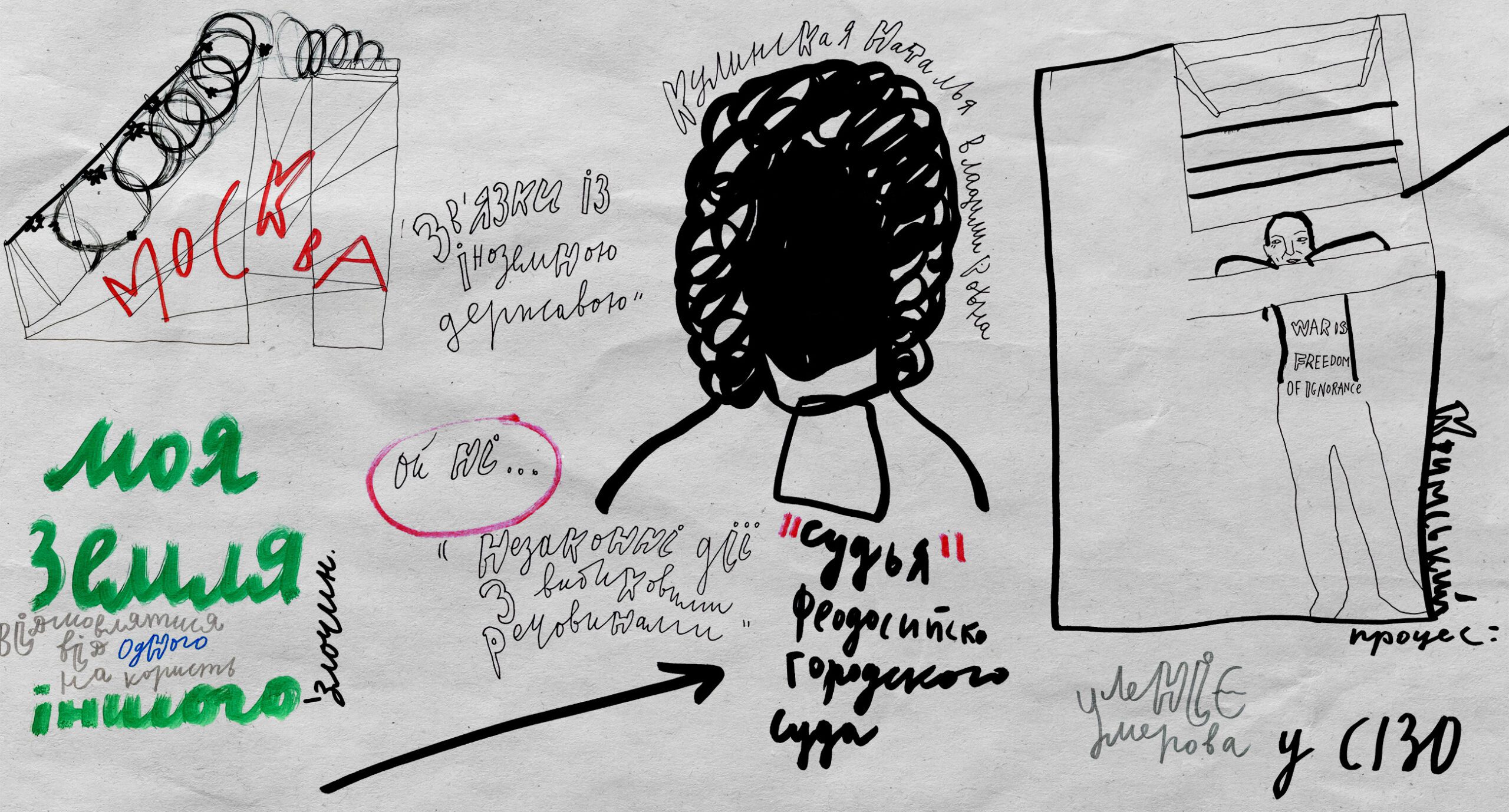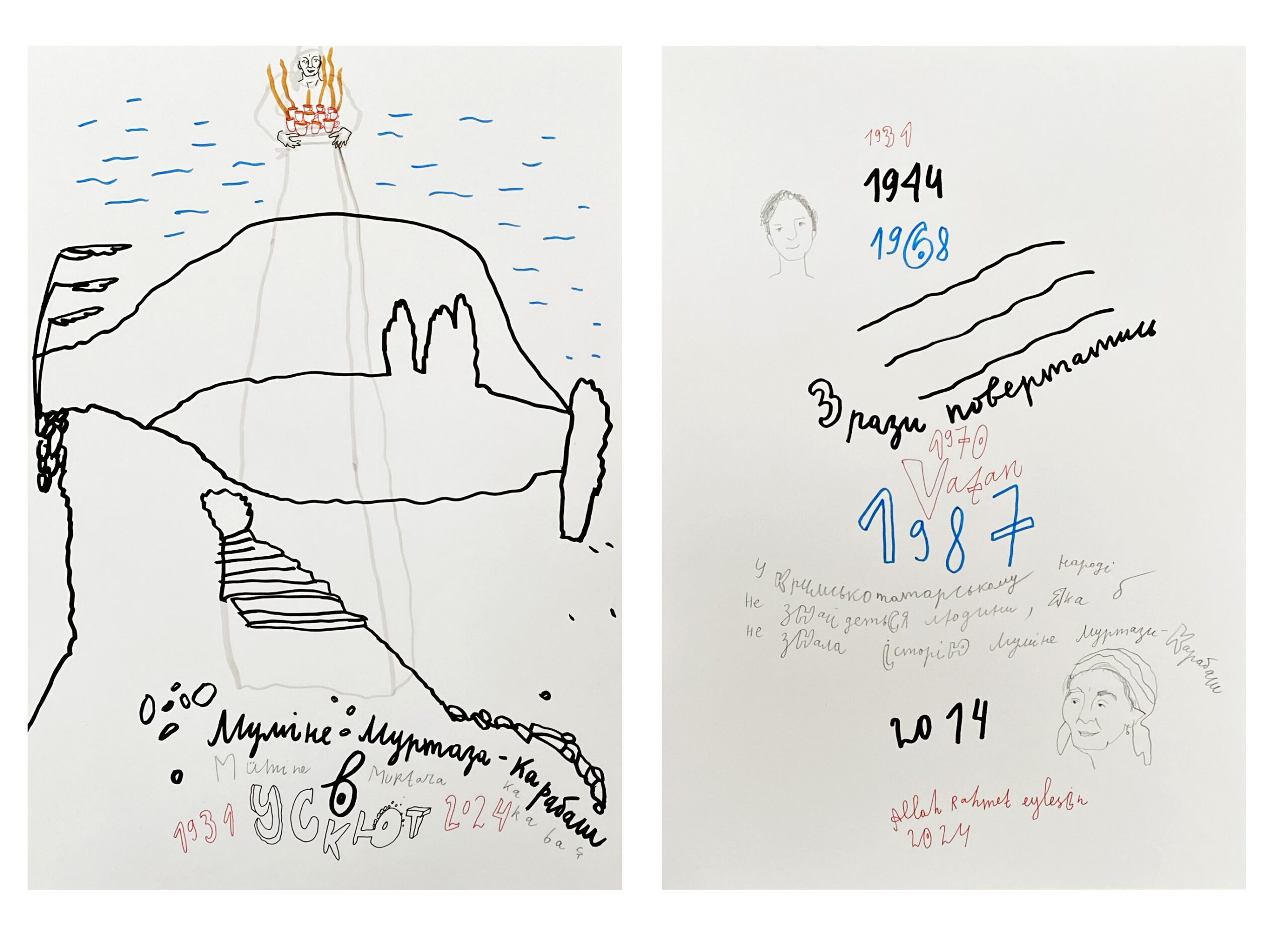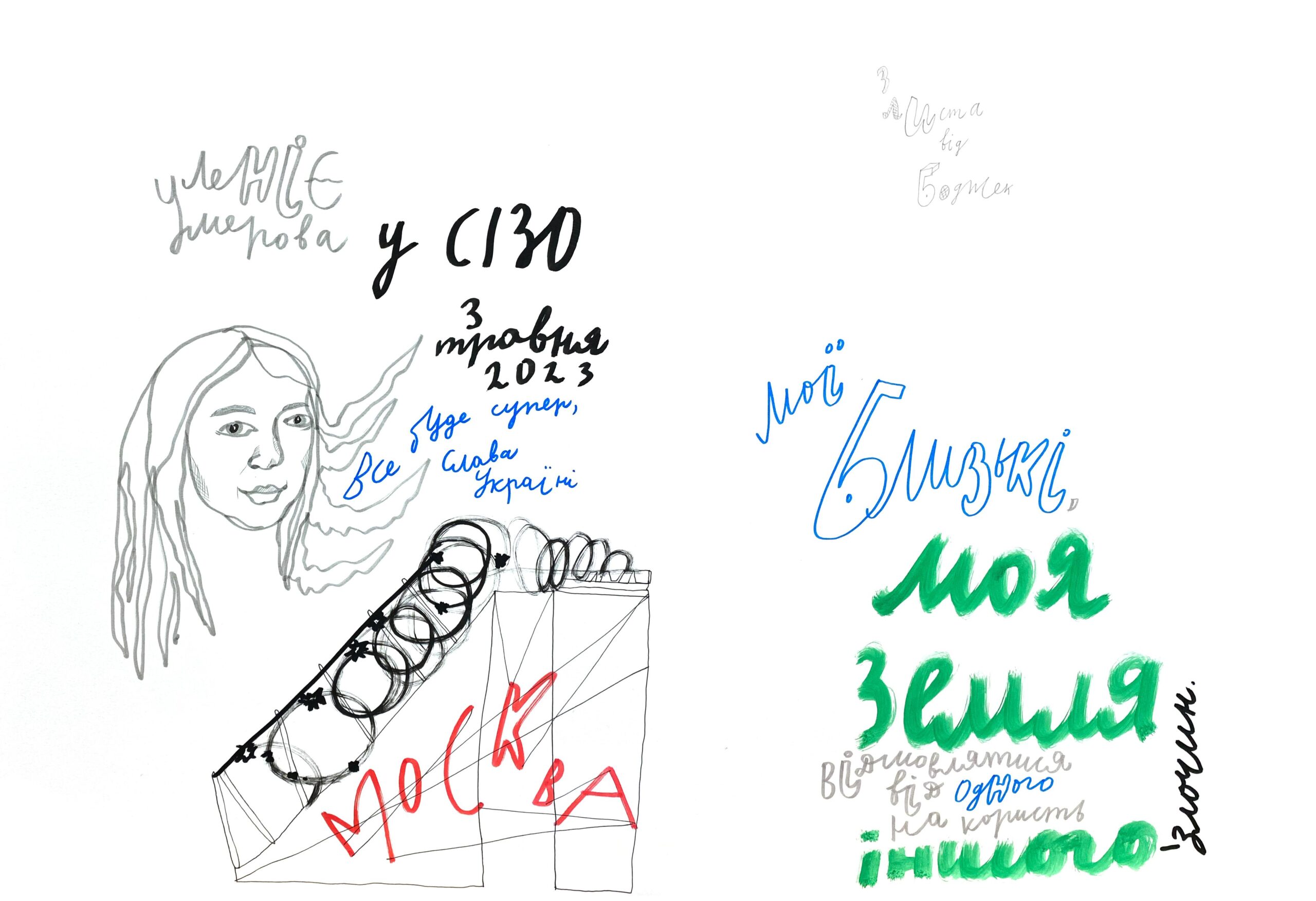The exhibition “LOMYKAMIN. Women’s Resistance in Crimea” has opened in Kyiv. It tells the stories of women who were illegally imprisoned for supporting Ukraine. Honoring the willpower of those who resist the occupiers daily, the exhibition shows that over the past 10 years, the Crimean resistance has not stopped for a second. It features the works of contemporary Ukrainian artists whose lives or artistic practice are closely connected with Crimea and the experience of living under occupation — Emine Ziyatdinova, Alevtina Kakhidze, Maria Kulikovska, Lia Dostleva, Yulia Po, and diaries of activists of the women’s resistance movement “Zla Mavka.”
Zaborona spoke with Alevtina Kakhidze about the stories of the three women the artist reflects on in her work.
Alevtina Kakhidze: about the artist and her project
Kakhidze explores complex issues, one of which is life in conflict zones. For example, Alevtina created the project “Klubnika Andriivna”, a story about her mother’s life in Zhdanivka, Donetsk region, which Ukraine does not control.
In her works, the artist also talks about those illegally imprisoned by the occupiers in Crimea — political prisoners, Ukrainian and Crimean Tatar activists, civilians. The prisoners are not provided with decent medical care and are subjected to torture. Alevtina emphasizes these situations and makes these stories visible. “The stories of these people are missed, not realized. I can’t imagine how we can achieve anything in Ukraine, any justice and a good future, if we don’t work together and leave the burden on them. We don’t even know how to write Crimean Tatar names — with a space, a hyphen, or not. This information gap is terrible, a shame for a political nation.”
The artist’s works serve as her own acquaintance with these people. “This is the way I coexist with information: to perceive anything, to be able to reflect on it, I have to draw these events, people, and their stories — this is how my visual notes come out,” explains the artist Alevtina Kakhadze and shares the stories of her characters. “Lenie Umerova, a very young girl, has been in a detention center in Moscow since May 2023. Mumine Murtaza-Karabash, now deceased, Halyna Dovhopola, an elderly woman whose story is extremely telling, because she was tried for something she did not do. Like Iryna Danylovych, whom I have been drawing for a long time. I started with her. I’m not someone who can analyze the actions of the Russian authorities, but it seems to me that they take one person and make a horrible case out of them to scare the others.”
Mumine Murtaza-Karabash
“Mumine Murtaza-Karabash has resisted all her adult life. Since the deportation in 1944, as soon as she became an adult, she began to return to Crimea. She was sent back, but kept looking for new ways. She returned to her native land three times,” Alevtina shares her research. Trying to avoid deportation, Mumine’s family lived in airports, parks, and train stations. On one of their returns, they bought a house, but the local authorities took it away by force. There was a time when Mumine and her husband lived with their children in a dugout. They were not allowed to work or send their children to school. After all these hardships, it was only in 1987 when Murtaza-Karabash could finally return to her native Uskut, which is on the southern coast of Crimea.
“In 2014, of course, she stayed and resisted. She was a legend, a leader, she had lots of conversations, support from her community… There is no one among the Crimean Tatar people who does not know her, so I wanted to find out about her, too. I learned where she was born, and where she lived. She really wanted to get into her own house, and it was impossible. This is also part of the story I drew,” the artist says.
Mumine Murtaza-Karabash died in 2024 in the occupied Crimea. She was 93 years old.

A drawing by Alevtina Kakhidze. Photo courtesy of Alevtina Kakhidze
Lenie Umerova
Lenie Umerova is 25 years old, a Crimean Tatar, and she has been under investigation in a Moscow pre-trial detention center for more than a year, suspected of treason and espionage among other things.
In 2014, she refused to receive Russian documents and moved to mainland Ukraine. The occupiers illegally detained Lenie in December 2022, when she was on her way to visit her father, who was sick with cancer in the occupied Crimea. She was arrested on the Georgian-Russian border, allegedly for violating the rules of the restricted zone.
Several times, Lenie Umerova was sentenced to 15 days of administrative arrest. A few months later, a case was fabricated on charges of espionage. The court has now extended her arrest until May 2024, and her case has been classified. The latest we know about her is that she faces up to 20 years in prison.

A drawing by Alevtina Kakhidze. Photo courtesy of Alevtina Kakhidze
Iryna Danylovych
Alevtina Kakhidze dedicated one of her projects to Iryna Danylovych, who was also persecuted by Russia in Crimea. She worked as a nurse, wrote several columns on the rights of healthcare workers and healthcare issues in the occupied Crimea, was one of the first correspondents of the Crimean Process; she supported Crimean activists in courts and recorded violations of human rights under occupation.
“There is a big difference between our judicial system and the Russian one. In our courts, I came across Soviet-type judges who did not understand what an outsider listener or artist could do in court. But it’s really a paradise that people in Ukraine can freely observe what is happening in the courts,” Kakhidze notes. “I go to hearings that I consider important — for example, I made sketches from the trial of the Berkut officers who shot protesters on the Maidan — and often find myself in a situation where among those present there is the judge, the defender, the prosecutor, the accused, and me. And that’s it. Iryna did this too, but it was a risk, and she ended up in prison.”
After Russia’s full-scale invasion of Ukraine in 2022, Iryna was arrested and held in a basement for about a month. The occupiers claimed that they had allegedly found explosives in her possession. In January 2023, Danylovych was illegally sentenced to 7 years in prison and transferred to the Krasnodar Women’s Correctional Colony #7 in Zelenokumsk, Stavropol Territory, Russia.

A drawing by Alevtina Kakhidze. Photo courtesy of Alevtina Kakhidze
“In court, they seriously discussed the fact that Iryna had everything in her bag to make a bomb. This is nonsense. There were incidents when the witness took a piece of paper and read what he had to say. Even the so-called judges asked: ‘What is this? A cheat sheet?’ and the witness replied: ‘Well, yes, to free up my memory.’ Iryna was asked whether she wanted to make a final statement or had any questions for the witness. ‘I only have one question,’ she replied. ‘When will I finally switch places with him?’”
In the colony, Danylovych’s condition is deteriorating: she has completely lost hearing in her left ear and suffers from headaches and earaches. This is the result of the lack of quality and timely medical care. Despite this, even behind bars, the Ukrainian continues to resist the occupiers and support her country.
“I have been drawing Iryna Danylovych for a long time. There is almost no information about her court hearings, even though they are open, so I talked to her family to imagine that I was there,” the artist says. “I found some information in open sources: her remarks, what she said in court, who tried her, all these names — I was able to write it all down. I am so far away from her, but I know what she said, I know that she came to the hearings wearing T-shirts with symbolic inscriptions. I also know about her tattoo: ‘Freedom is our religion.’ That’s the kind of person she is.”








